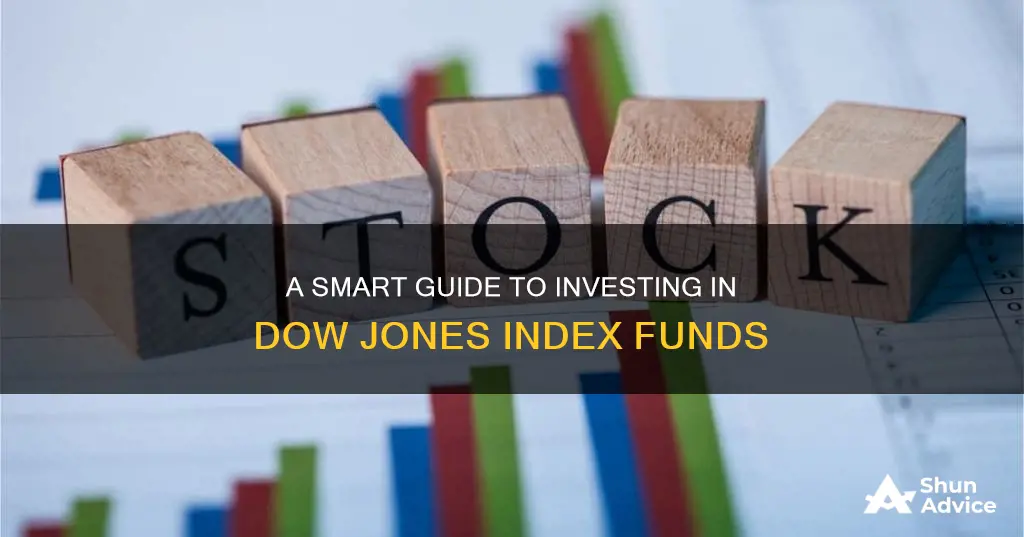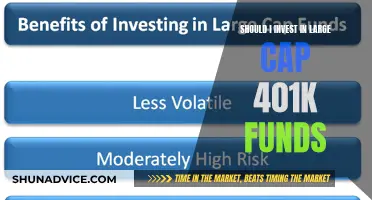
The Dow Jones Industrial Average (DJIA) is one of the world's most-watched stock market indices, used as a gauge for the general well-being of corporate America. It is one of the largest stock indexes in the world, representing the average price of 30 large US companies, or 'blue-chip' stocks, each with a history of strong performance.
Because the DJIA is a measure and not a purchasable vehicle itself, it is not possible to own shares of it directly. However, there are several investment products available that yield similar results to the performance of the index. These include buying shares of the 30 individual stocks in the index, or buying index funds or exchange-traded funds (ETFs) that track the index.
One such ETF is the SPDR Dow Jones Industrial Average ETF (DIA), which trades at roughly 1/100 of the Dow Jones index price. Another is the ProShares Short Dow 30 ETF (DOG), which moves in the opposite direction of the Dow Jones, meaning that investors can buy shares and see their share value increase as the Dow Jones falls.
| Characteristics | Values |
|---|---|
| Index name | Dow Jones Industrial Average (DJIA) |
| Description | Reflects the average price of the 30 stocks included in the measurement |
| Investability | Cannot invest in the index itself, but there are investment products available that yield similar results to the performance of the index |
| Examples of investment products | Individual stocks, index funds, or ETFs that track the index |
| Example of an ETF | SPDR Dow Jones Industrial Average ETF (DIA) |
| Example of a strategy | "Dogs of the Dow," which focuses on the 10 highest-yielding stocks on the index |
| Example of a fund | ProShares Short Dow 30 ETF (DOG), which moves in the opposite direction of the Dow Jones |
| Index weighting method | Price-weighted |
| Number of companies in the index | 30 |
| Companies in the index | The Coca-Cola Company, McDonald's Corporation, The Walt Disney Company, Merck & Co., Inc., International Business Machines Corporation, Johnson & Johnson, The Boeing Company, UnitedHealth Group Incorporated, The Home Depot, Inc., Intel Corporation, Cisco Systems, Inc., Microsoft Corporation, The Procter & Gamble Company, Verizon Communications Inc., The Travelers Companies, Inc., Honeywell International Inc., JPMorgan Chase & Co., American Express Company, Caterpillar Inc., Chevron Corporation, Salesforce.com, inc., The Goldman Sachs Group, Inc., Walgreens Boots Alliance, Inc. |
| Calculation method | Weighted price calculation with the Dow correction factor |
| Investment instruments | Stocks, options, futures, CFDs, ETFs |
| Example of a CFD | US30IndexCash |
What You'll Learn

Buying individual stocks vs. index funds or ETFs
When deciding whether to invest in individual stocks or index funds/ETFs, it's important to consider the benefits and drawbacks of each option. Here are some key points to keep in mind:
Individual Stocks:
- Advantages: Investing in individual stocks can offer the potential for very high returns. If you pick a winning company, you can beat the market and outperform most ETFs. You also have more control over your investments and can take advantage of your knowledge of a particular industry or stock. Additionally, commissions on stock trading have been reduced to zero at major online brokers.
- Disadvantages: Investing in individual stocks can be risky as your capital is tied to the performance of a single company. Stocks can be volatile and fluctuate significantly in the short term. Analyzing and valuing individual stocks requires a lot of time and effort.
Index Funds/ETFs:
- Advantages: Index funds and ETFs provide diversification, reducing risk and increasing returns. They are less volatile than individual stocks and offer a convenient way to invest in a variety of assets without the need for active management. They tend to have lower expense ratios and are traded without commissions at most major online brokers.
- Disadvantages: ETFs may underperform the best-performing individual stocks within the fund. They charge management fees, which can impact your total return. You have less control over the specific investments within the fund.
Ultimately, the decision between investing in individual stocks or index funds/ETFs depends on your investment goals, risk tolerance, and the amount of time and effort you are willing to dedicate to researching and monitoring your investments. Both options have their advantages and can be used in combination to further diversify your portfolio.
Investing in the Dow Jones Industrial Average (DJIA)
The DJIA is one of the largest and most-watched stock market indices in the world, comprising 30 large, blue-chip US companies. While you cannot invest directly in the index itself, there are several ways to gain exposure to the DJIA:
- Buying individual stocks: You can purchase shares of each of the 30 companies in the index. However, this can be costly and requires active management as the index composition changes periodically.
- Index funds: You can invest in index funds linked to the DJIA, which aim to replicate the performance of the index at a lower cost.
- ETFs: ETFs that track the DJIA provide a cost-effective and convenient way to invest in all 30 stocks in the index. Examples include the SPDR Dow Jones Industrial Average ETF (DIA) and the ProShares Short Dow 30 ETF (DOG), which moves in the opposite direction of the DJIA.
Roth IRA vs. Mutual Funds: Why Choose the Former?
You may want to see also

Understanding the Dow Jones Industrial Average (DJIA)
The Dow Jones Industrial Average (DJIA) is one of the world's most well-known and oldest stock indices. It is also one of the top three indices in the US, with the best market capitalisation among them. The DJIA includes the stocks of the 30 leading large-cap companies in the US, indicating the economic situation in the country.
The DJIA was created in 1896 by Charles Henry Dow, the editor of the famous Wall Street Journal, and his business partner, Edward Davis Jones. Initially, the index consisted primarily of industrial companies producing and selling oil, gas, sugar, tobacco, and cotton, among other things. Today, the 30 companies of the index boast the highest capitalisation and ratings of reliability. To be included in the DJIA, a company must be a significant part of US economic activity, be registered in the NASDAQ or NYSE, and be one of the largest industrial companies in the country.
The DJIA is a price-weighted index, meaning it gives more weight to companies with higher share prices. This means that any changes in the stock prices of companies with high share prices will significantly influence the whole index. The performance of the DJIA is often used as a proxy for the overall US stock market and the general well-being of corporate America.
There are various ways to invest in the DJIA, including buying stocks from the index directly, investing in futures and options, or using exchange-traded funds (ETFs) and contracts for difference (CFDs).
While it is not possible to buy shares of the DJIA directly, investors can buy shares of the 30 individual companies in the index or invest in index funds or ETFs that track the index. Some ETFs to consider include the SPDR Dow Jones Industrial Average ETF (DIA) and the ProShares Short Dow 30 ETF (DOG), which moves in the opposite direction of the DJIA, allowing investors to profit in a bear market.
The DJIA is a high-liquidity asset, and investors can use various financial instruments such as stocks, options, futures, CFDs, and ETFs to implement different investment strategies.
Bond Fund Benefits: Diversify and Gain with Less Risk
You may want to see also

Choosing between mutual funds and exchange-traded funds (ETFs)
When choosing between mutual funds and exchange-traded funds (ETFs) for investing in the Dow Jones Industrial Average (DJIA), there are several key factors and differences to consider:
Similarities:
- Both mutual funds and ETFs are investment funds that provide a diversified portfolio of stocks and/or bonds, reducing risk compared to investing in individual stocks or bonds.
- They are both overseen by professional portfolio managers who select and monitor the investments, saving you time and effort.
- Both options can provide exposure to the DJIA, allowing you to track its performance.
Differences:
- ETFs are bought and sold on a stock exchange throughout the trading day, like individual stocks, offering more flexibility and control over the price of your trade. Mutual funds, on the other hand, are traded only once a day at the market close, and the price is the same for all investors regardless of the time of their order.
- ETFs often have lower investment minimums, allowing you to buy for the price of a single share. Mutual funds usually have flat-rate minimum initial investments, which can range from $500 to $5,000 or more.
- ETFs typically have lower fees and expenses, with the average stock ETF having an expense ratio of 0.16% compared to 0.47% for stock mutual funds. However, when comparing index mutual funds and ETFs, this difference may be negligible.
- ETFs may be more tax-efficient than mutual funds as they have fewer taxable events and can limit capital gains distributions for shareholders.
- Mutual funds are regulated by the Securities and Exchange Commission (SEC) and are required to publish a prospectus and fact sheets with key information. This provides transparency and reliability of information when comparing different funds.
- Mutual funds are commonly available through workplace retirement plans and often have tax advantages when held in these accounts.
In summary, both mutual funds and ETFs can be suitable options for investing in the DJIA, offering diversification and professional management. However, ETFs may provide more flexibility and potentially lower costs and taxes, while mutual funds offer simpler, less frequent trading and are widely available through retirement plans. The choice between the two depends on your investment goals, preferences, and constraints.
Bond Funds vs Individual Bonds: Which is the Better Investment?
You may want to see also

Weighing up the pros and cons of investing in index funds
Index funds are a popular investment choice as they offer the potential for more stable returns, a diversified portfolio of holdings and low fees. However, it's important to be aware of their potential downsides. Here are some pros and cons of investing in index funds to help you make an informed decision.
Pros of Investing in Index Funds:
- Low Cost and Passive Management: Index funds are passively managed, meaning fund managers take a hands-off approach. They do not actively research and choose investments, and instead, track a specific stock market index. This passive management style results in lower fees for investors.
- Diversification: Index funds provide instant diversification by giving you access to a large collection of stocks, bonds, or other securities. This diversification reduces your risk as your portfolio is less likely to be significantly impacted by the poor performance of a single stock.
- Long-Term Performance: Index funds tend to provide more stable and predictable returns over the long term. They are often considered excellent core assets for retirement accounts due to their potential for consistent returns.
- Attractive Returns: While indexes fluctuate, they have made solid returns over time. For example, the S&P 500 has a long-term record of about 10% annual returns.
- Lower Risk: Investing in an index fund is generally lower risk than owning a few individual stocks due to the diversification of holdings.
Cons of Investing in Index Funds:
- Lack of Downside Protection: Index funds leave you vulnerable to market downturns. When the market performs poorly, your index fund will likely follow suit.
- Lack of Reactive Ability: Index funds do not allow you to take advantage of specific investment opportunities. If a stock becomes overvalued, it carries more weight in the index, but this is when you would want to reduce your exposure to that stock.
- No Control Over Holdings: With index funds, you cannot choose the individual holdings in your portfolio. You may have specific companies you want to invest in or avoid for personal reasons, but this is not possible with index funds.
- Limited Exposure to Different Strategies: Index funds may not give you access to successful investing strategies as they are limited to well-established investment styles and sectors.
- Dampened Personal Satisfaction: Investing in index funds may not provide the same level of personal satisfaction and excitement as actively choosing individual stocks.
In summary, index funds offer benefits such as diversification, lower fees, and stable long-term returns but lack the flexibility and control that come with actively managed investments. It's important to weigh these pros and cons before deciding if index funds align with your investment goals and risk tolerance.
Emergency Fund Strategies: UK Investment Options for Peace of Mind
You may want to see also

How to get started with investing in index funds
Index funds are a great way to get started with investing. They are a type of investment fund, either a mutual fund or an exchange-traded fund (ETF), that is based on a preset basket of stocks or an index. The fund managers aim to replicate the index without actively managing it. Index funds are popular because they offer ownership of a wide variety of stocks, greater diversification, and lower risk, usually at a low cost.
- Pick your exchange: Choose an index that aligns with your investment goals and risk tolerance. For example, the NASDAQ focuses on growth stocks and tends to be more aggressive, while the Dow Jones Industrial Average (DJIA) and S&P 500 are less volatile. Study the historical performance and composition of different exchanges before deciding.
- Pick your fund: Select a fund provider, such as Vanguard, Fidelity Investments, or Charles Schwab, that offers index funds for your chosen exchange. Compare the fees and performance of different fund providers to make an informed decision.
- Open an investment account: Choose an investment company, such as Vanguard or Fidelity, to open an investment account. Consider the brokerage fees and account-opening process when making your decision.
- Purchase the index fund: After selecting your fund and opening an account, you can proceed to purchase the index fund. You can usually buy the fund directly from the fund company or through a broker.
It is important to note that while index funds offer diversification and lower costs, they may not be suitable for everyone. They can encourage investor passivity, and some investors may prefer actively managed funds that aim to outperform the market. Additionally, index funds may not provide the same level of diversification as investing in a broader range of assets, such as bonds, real estate, or other non-equities.
Pension Planning: Choosing the Right NPS Fund
You may want to see also
Frequently asked questions
No, you cannot buy shares in the DJIA directly as it is simply a calculated average. However, you can buy shares in the 30 individual companies that make up the index. Alternatively, you can invest in index funds or exchange-traded funds (ETFs) that track the index.
The DJIA includes some of the largest and most reliable companies in the US, such as Coca-Cola, Microsoft, and Johnson & Johnson. As such, it is often used as a gauge of the overall US stock market and the general well-being of corporate America.
While the companies in the DJIA are generally considered reliable, their stock prices can fluctuate significantly during periods of high market volatility. Therefore, investing in the DJIA can entail either significant short-term losses or profits.







